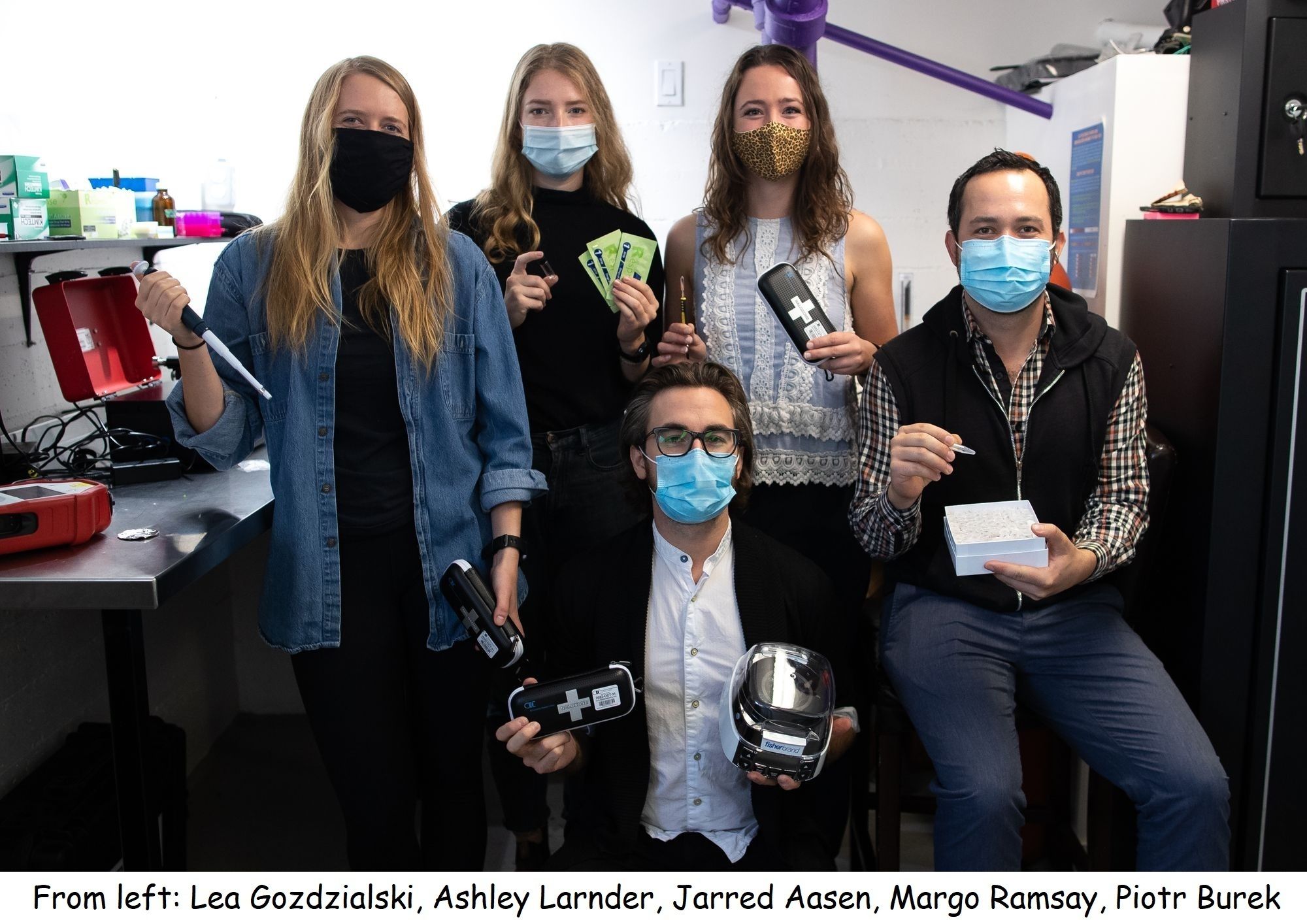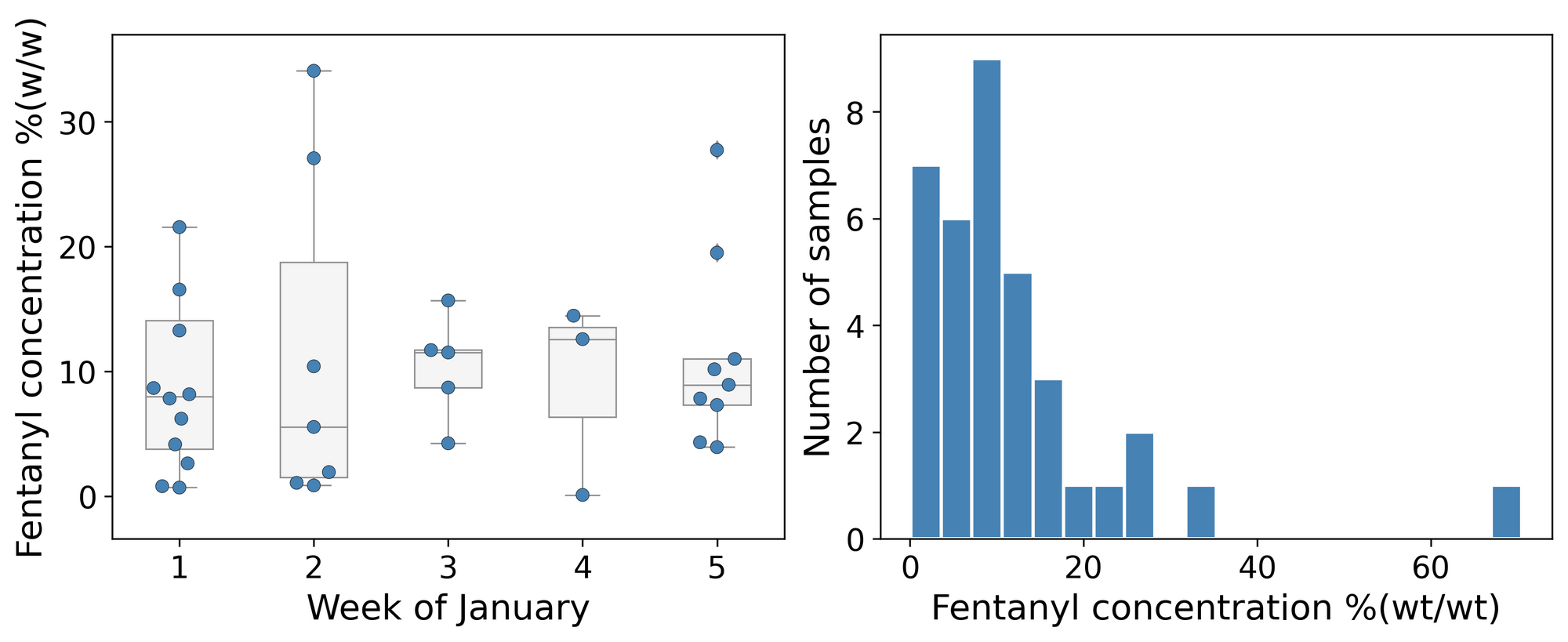January 2021 Monthly Report

In this blog post we discuss our January 2021 report and provide more information on how to interpret the results. We are excited to announce the additional reporting of fentanyl, etizolam, heroin, and carfentanil concentrations through our collaboration with Dr. Chris Gill and his team at Vancouver Island University. The PDF report can be found at the end.
Key findings:
- Novel finding of the synthetic opioid isotonitazene in an expected oxycodone sample
- Carfentanil found in 8 samples, half of which were expected opioid-down samples
- 43% of samples containing fentanyl found to have concentrations greater than 10%
- Fentanyl median concentration of 8.2% found, with a max concentration of 70% found in an expected opioid-down sample
- Benzodiazepine drugs and/or etizolam found in 50% expected opioid-down samples
- Etizolam found in 37% of expected opioid-down samples
- Etizolam median concentration of 1.2% found, with a max concentration of 15% found in an expected Xanax sample
Insight for the January 2021 Monthly Report
2021 has started off with a bang for our service. We saw a 77% increase in service uptake in comparison to the previous two years.

Expected Other Opioid
This January we found isotonitazene in a tablet expected to be oxycodone. This designer drug is a synthetic version of the opioid etonitazene and is a strong opioid. Though it doesn’t react with fentanyl test strips, it still responds to Naloxone. Isotonitazene was reported being found in the illicit drug supply in Montreal in November 2020.
Are all drugs cut?
No! For many drug types, we often find over half of the drugs to be uncut. When we say uncut, we mean that through our various technologies we find nothing additional to the expected drug.
Methamphetamine - 6/8 samples (75%) only found to contain methamphetamine. The other two contained dimethyl sulfone (inert cut).
Cocaine - 19/26 samples (73%) only found to contain cocaine. When cut, samples contained various agents, including glutamine (an amino acid), sugars, talc (clay powder), phenacetin (acetaminophen-like substance), procaine and benzocaine (topical anesthetics).
Ketamine - 3/4 samples (75%) found to contain only ketamine. The other sample contained trace level MDMA.
Expected Benzodiazepine
2 expected Xanax (alprazolam): instead of alprazolam, we found etizolam in one sample and flualprazolam in the other.
1 unspecified benzo: we found fentanyl and etizolam. Rather than tablet form, this sample was a coloured powder similar in appearance to opioid-down samples.
Expected Opioid Down
In this section we will present statistics specific to the opioid-down supply, therefore they may differ from the highlighted findings above that are inclusive to all expected drug categories.
Fentanyl and analogues
- 95% expected opioid samples contain fentanyl (36/38)
- 44% samples contained over 10% fentanyl (16/36)
- 11% samples contained carfentanil (4/38)
- Acetyl fentanyl found in one sample
Benzos and Etizolam
- 50% contained a benzo and/or etizolam (19/38)
- 37% samples contained etizolam (14/38)
- 18% samples contained benzodiazepine (7/38)
55% of opioid-down samples contained an active in addition to fentanyl and/or heroin. These actives come in various combinations. A comprehensive list for January combinations can be seen in Table 2.

Spotlight sample
The sample containing heroin, carfentanil and etizolam as its actives was found to have a positive fentanyl strip test and a negative benzo strip test during our drug checking service. As no fentanyl was found, we can assume the positive fentanyl strip is due to carfentanil, which reaffirms the strips are able to detect carfentanil. The negative benzo strip shows an ongoing challenge with the benzo strips: that our project is unable to detect etizolam using these strips. Etizolam was later confirmed by paper spray - mass spectrometry in this case.
Quantification for expected opioid-down
These values are different from those contained in the report as these are restricted to expected opioid-down samples.

In January, we quantified fentanyl for all 36 of the expected opioid-down samples that contained fentanyl. We found the median concentration to be 8.7% fentanyl, which is very similar to the median concentration of 8.8% fentanyl found in December. Figure 1 demonstrates the spread of fentanyl concentrations in January by week (left) and for the month overall (right).
The average strength of fentanyl in opioid-down we see during service in general is around 10%. The median concentration of 8.7% fentanyl for January is at this average strength. Our findings illustrate the variable concentrations of fentanyl in the opioid-down supply, as any one sample may be low strength (less than 1% fentanyl) or very strong (over 70% fentanyl). Overall, 44 percent of samples were found to be above average strength (greater than 10% fentanyl). Interestingly, this is the same proportion as found in our December data.

In comparing our drug data to the BC Coroner report’s post-mortem toxicology data there are striking similarities. Read more about these similarities here.
Want to be notified when we release these reports? Join our new mailing list to receive updates about when our reports are out. You can subscribe and unsubscribe yourself from this list at any time.
Check back next month for the February report!
As always, send us feedback at substance@uvic.ca for how we can continue to offer our drug checking results in a useful way.
